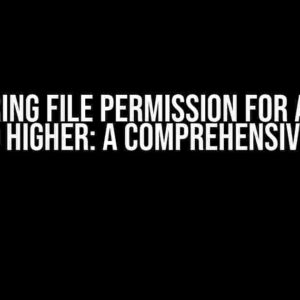Are you tired of banging your head against the wall because of the infamous MissingPluginException when trying to integrate a Flutter module as an AAR in your native Android project? Fear not, dear developer, for we’ve got you covered! In this comprehensive guide, we’ll take you by the hand and walk you through the solution to this pesky problem.
What is the MissingPluginException?
The MissingPluginException is an exception thrown by the Flutter engine when it can’t find a required plugin or module. This usually happens when there’s a mismatch between the Flutter module and the native Android project. It’s like trying to fit a square peg into a round hole – it just won’t work!
Why does it happen?
There are several reasons why the MissingPluginException might occur when using a Flutter module as an AAR in a native Android project:
- Mismatched plugin versions: When the plugin versions in the Flutter module and the native Android project don’t match, the Flutter engine gets confused.
- Incorrect configuration: If the Flutter module is not configured correctly, the plugins won’t be registered properly, leading to the MissingPluginException.
- Plugin not included in the AAR: If the plugin is not bundled with the AAR, the Flutter engine won’t be able to find it.
Solving the MissingPluginException
Now that we’ve identified the culprits, let’s dive into the solutions! Follow these steps to resolve the MissingPluginException:
Step 1: Check the plugin versions
Make sure the plugin versions in your Flutter module and native Android project match. You can check the plugin versions in your `pubspec.yaml` file:
dependencies:
flutter:
sdk: flutter
flutter_plugin: ^1.2.3
Verify that the same version is used in your native Android project’s `build.gradle` file:
dependencies {
implementation 'com.example:flutter_plugin:1.2.3'
}
Step 2: Configure the Flutter module correctly
In your Flutter module’s `android` directory, open the `build.gradle` file and add the following code:
android {
...
defaultConfig {
...
ndk {
abiFilters 'armeabi-v7a', 'x86'
}
}
}
This code ensures that the Flutter module is built with the correct architecture.
Step 3: Include the plugin in the AAR
To include the plugin in the AAR, you need to add the following code to your Flutter module’s `build.gradle` file:
android {
...
defaultConfig {
...
aarConfig {
includeTransitive true
}
}
}
This code tells Gradle to include the transitive dependencies (i.e., the plugins) in the AAR.
Step 4: Initialize the Flutter engine
In your native Android project, initialize the Flutter engine by adding the following code to your `MainActivity.java` file:
import io.flutter.embedding.android.FlutterActivity;
import io.flutter.embedding.engine.plugins.FlutterPlugin;
public class MainActivity extends FlutterActivity {
@Override
protected void onCreate(Bundle savedInstanceState) {
super.onCreate(savedInstanceState);
FlutterPlugin flutterPlugin = new FlutterPlugin();
flutterPlugin.on attaches this);
}
}
This code initializes the Flutter engine and registers the plugins.
Additional Tips and Tricks
Here are some additional tips to help you troubleshoot and resolve the MissingPluginException:
- Use the correct Flutter engine version: Ensure that the Flutter engine version in your native Android project matches the version used in your Flutter module.
- Check the plugin’s Android implementation: Verify that the plugin’s Android implementation is correct and matches the version used in your Flutter module.
- Use the Android NDK: If you’re using native code in your Flutter module, make sure to include the Android NDK in your native Android project.
Conclusion
And there you have it, folks! By following these steps and tips, you should be able to resolve the MissingPluginException when using a Flutter module as an AAR in your native Android project. Remember to double-check the plugin versions, configure the Flutter module correctly, include the plugin in the AAR, and initialize the Flutter engine.
Don’t let the MissingPluginException hold you back from creating amazing hybrid apps with Flutter and native Android. Happy coding!
| Plugin Version | Flutter Module | Native Android Project |
|---|---|---|
| 1.2.3 | dependencies: flutter_plugin: ^1.2.3 | dependencies { implementation ‘com.example:flutter_plugin:1.2.3’ } |
| 1.3.0 | dependencies: flutter_plugin: ^1.3.0 | dependencies { implementation ‘com.example:flutter_plugin:1.3.0’ } |
Here’s a sample table illustrating the plugin version mismatch. Make sure to keep the versions consistent across both the Flutter module and native Android project!
Additional resources for further learning and troubleshooting:
Frequently Asked Question
Get answers to the most common questions about the dreaded MissingPluginException when using Flutter module as AAR in native Android project. We’ve got you covered!
What is the MissingPluginException, and why does it haunt me?
The MissingPluginException is a runtime error that occurs when the Flutter engine can’t find a required plugin or module. This might happen when you’re using a Flutter module as an AAR in a native Android project. It’s usually caused by a mismatch between the plugin versions or a failure to register the plugins correctly. Don’t worry, it’s a common issue, and we’re here to help you resolve it!
How do I check if I’ve registered my plugins correctly?
To register your plugins, you need to call the `registerWith` method in your Flutter module’s `public class FlutterPlugin` implementation. Make sure you’re passing the correct `registrar` instance to the `registerWith` method. If you’re still stuck, double-check your plugin registration and verify that you’ve added the necessary plugins to your `flutter` section in the `build.gradle` file.
What’s the deal with plugin versions? How do I manage them?
Plugin versions can be a real headache! Make sure you’re using the same version of the plugin in your Flutter module and native Android project. You can do this by specifying the exact version in your `build.gradle` file or `pubspec.yaml`. If you’re using a plugin that depends on another plugin, ensure that the dependent plugin is also added to your project with the correct version. Consistency is key here!
Can I use a custom Flutter module in my native Android project?
Yes, you can use a custom Flutter module in your native Android project! When creating a custom Flutter module, make sure to follow the official guidelines and create a valid AAR file. Then, add the AAR file to your native Android project and register the plugins as usual. If you encounter any issues, double-check your module’s `AndroidManifest.xml` file and ensure that it’s correctly configured.
What’s the last resort if I’ve tried everything and the error persists?
If you’ve tried all the above steps and the MissingPluginException still haunts you, it’s time to dig deeper! Check the Android logcat for more detailed error messages, and verify that your Flutter module is correctly initialized. If all else fails, try cleaning and rebuilding your project, or even creating a new project from scratch. If you’re still stuck, don’t hesitate to seek help from the Flutter community or a trusted developer friend.



